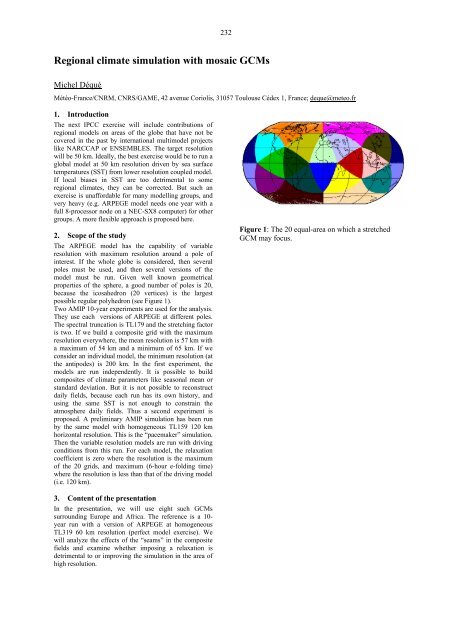Low (web) Quality - BALTEX
Low (web) Quality - BALTEX
Low (web) Quality - BALTEX
Create successful ePaper yourself
Turn your PDF publications into a flip-book with our unique Google optimized e-Paper software.
232<br />
Regional climate simulation with mosaic GCMs<br />
Michel Déqué<br />
Météo-France/CNRM, CNRS/GAME, 42 avenue Coriolis, 31057 Toulouse Cédex 1, France; deque@meteo.fr<br />
1. Introduction<br />
The next IPCC exercise will include contributions of<br />
regional models on areas of the globe that have not be<br />
covered in the past by international multimodel projects<br />
like NARCCAP or ENSEMBLES. The target resolution<br />
will be 50 km. Ideally, the best exercise would be to run a<br />
global model at 50 km resolution driven by sea surface<br />
temperatures (SST) from lower resolution coupled model.<br />
If local biases in SST are too detrimental to some<br />
regional climates, they can be corrected. But such an<br />
exercise is unaffordable for many modelling groups, and<br />
very heavy (e.g. ARPEGE model needs one year with a<br />
full 8-processor node on a NEC-SX8 computer) for other<br />
groups. A more flexible approach is proposed here.<br />
2. Scope of the study<br />
The ARPEGE model has the capability of variable<br />
resolution with maximum resolution around a pole of<br />
interest. If the whole globe is considered, then several<br />
poles must be used, and then several versions of the<br />
model must be run. Given well known geometrical<br />
properties of the sphere, a good number of poles is 20,<br />
because the icosahedron (20 vertices) is the largest<br />
possible regular polyhedron (see Figure 1).<br />
Two AMIP 10-year experiments are used for the analysis.<br />
They use each versions of ARPEGE at different poles.<br />
The spectral truncation is TL179 and the stretching factor<br />
is two. If we build a composite grid with the maximum<br />
resolution everywhere, the mean resolution is 57 km with<br />
a maximum of 54 km and a minimum of 65 km. If we<br />
consider an individual model, the minimum resolution (at<br />
the antipodes) is 200 km. In the first experiment, the<br />
models are run independently. It is possible to build<br />
composites of climate parameters like seasonal mean or<br />
standard deviation. But it is not possible to reconstruct<br />
daily fields, because each run has its own history, and<br />
using the same SST is not enough to constrain the<br />
atmosphere daily fields. Thus a second experiment is<br />
proposed. A preliminary AMIP simulation has been run<br />
by the same model with homogeneous TL159 120 km<br />
horizontal resolution. This is the “pacemaker” simulation.<br />
Then the variable resolution models are run with driving<br />
conditions from this run. For each model, the relaxation<br />
coefficient is zero where the resolution is the maximum<br />
of the 20 grids, and maximum (6-hour e-folding time)<br />
where the resolution is less than that of the driving model<br />
(i.e. 120 km).<br />
Figure 1: The 20 equal-area on which a stretched<br />
GCM may focus.<br />
3. Content of the presentation<br />
In the presentation, we will use eight such GCMs<br />
surrounding Europe and Africa. The reference is a 10-<br />
year run with a version of ARPEGE at homogeneous<br />
TL319 60 km resolution (perfect model exercise). We<br />
will analyze the effects of the “seams” in the composite<br />
fields and examine whether imposing a relaxation is<br />
detrimental to or improving the simulation in the area of<br />
high resolution.













